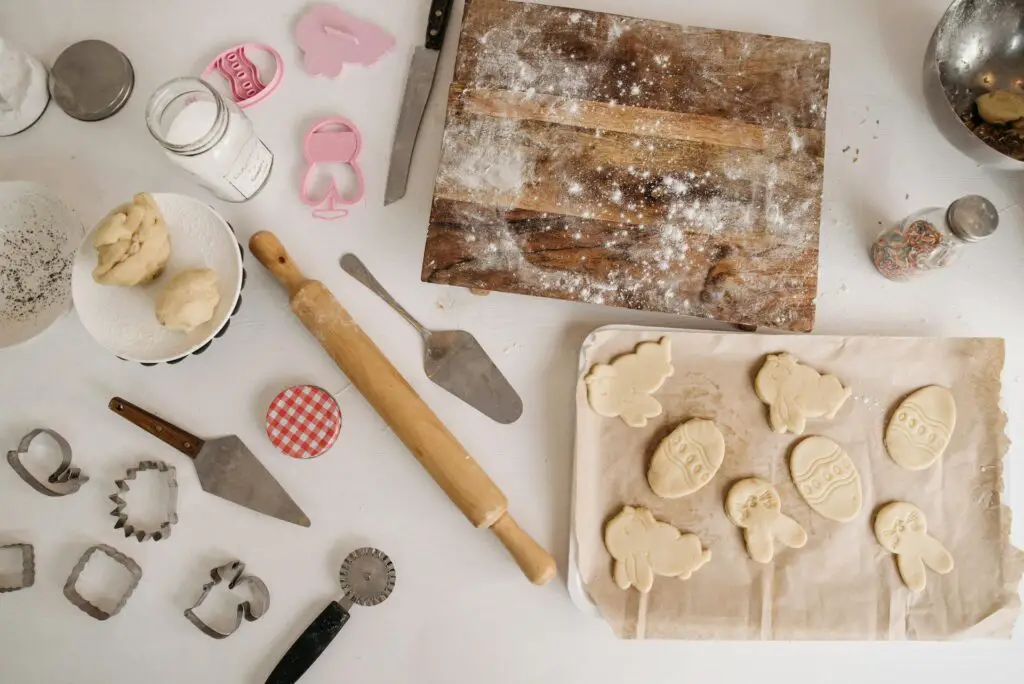Baking is supposed to feel fun and not like a scavenger hunt. Nothing kills the mood faster than digging through half-open bags of flour or mystery jars of sugar when all you want are cookies.
An organized pantry doesn’t just look nice—it saves time, keeps ingredients fresh, and makes baking feel effortless.
In this guide, you’ll get simple, step-by-step tips to turn your pantry into a space that actually works for you.
Take Inventory First
The first step to pantry bliss is pulling everything out—even the stuff crammed in the back that hasn’t seen daylight since last Christmas. Lay it all on the counter so you can actually see what you’re working with.
You’ll probably find expired baking powder (that explains the flat muffins), three half-used bags of brown sugar, and maybe even a spice jar older than your high school yearbook.
Toss what’s expired, donate anything you won’t realistically use, and combine duplicates into one airtight container to free up space.
Once the clutter is gone, jot down your must-have staples—things like flour, sugar, baking soda, cocoa powder, vanilla, and salt.
That list becomes your anchor, helping you keep track of essentials and avoid last-minute grocery runs when the baking itch hits.
Group Similar Items Together
Once your pantry is cleared and trimmed down to the essentials, it’s time to bring some order to the chaos by grouping like with like.
Keep all your dry goods—flours, sugars, oats, and cocoa—together so you’re not tearing the place apart when a recipe calls for more than one of them.
Corral your leavening agents, such as baking soda, baking powder, and yeast, into one container or basket; these little guys often get lost behind bigger bags, but they’re the secret weapons of rise and fluff.
Sweeteners like syrup, honey, and molasses belong in their own cluster, ideally on a tray or lazy Susan to catch drips and keep things tidy.
For add-ins like chocolate chips, nuts, and dried fruit, stash them in clear jars or bins so you can actually see what you have before impulse-buying another bag.
And finally, dedicate a small spice rack or bin to flavorings—vanilla, cinnamon, nutmeg, and their friends—because nothing derails a recipe faster than not finding the spice that makes it sing.
Grouping this way doesn’t just make your pantry look neat; it creates a mental map so you always know exactly where to reach when the baking mood strikes.
Use Clear Storage Containers
Clear containers are like giving your pantry a pair of glasses—it suddenly goes from blurry chaos to crystal clarity.
Airtight jars or canisters not only keep flour, sugar, and oats fresh, but they also stop pests and moisture from sneaking in, which is basically pantry sabotage.
When everything is see-through and labeled, you know exactly how much you’ve got left at a glance—no more opening a bag to find only a sad spoonful of cocoa powder when you were dreaming of brownies.
It also cuts down clutter since bulky bags and half-torn boxes disappear, replaced by neat, uniform rows.
Stackable bins are great for maximizing vertical space, mason jars work perfectly for smaller items like nuts or chocolate chips, and matching canisters instantly give your shelves that “Pinterest-worthy but still practical” vibe.
The best part? Refilling is easy and oddly satisfying—almost like a mini reset every time you stock up.
Label Everything
Labels are the unsung heroes of an organized pantry, saving you from the classic “is this flour or powdered sugar?” guessing game that usually ends in a baking flop.
You don’t need anything fancy—chalkboard labels are reusable and add charm, printed stickers look clean and professional, and even plain masking tape with a marker does the job perfectly.
The key is consistency, so every container speaks the same language when you glance at it. Clear labels also keep your family or housemates from accidentally pouring salt into the cookie jar (yes, it happens).
If you want to take it a step further, try color-coding: blue for dry goods, yellow for sweeteners, green for spices. It’s quick, fun, and makes finding what you need almost automatic.
Optimize Shelf Space
Think of your pantry shelves like real estate—prime spots should go to the things you reach for most.
Keep everyday items like sugar, flour, or chocolate chips at eye level so you’re not crouching or climbing every time you bake.
Heavy bags of flour or big tubs of oats belong on the bottom shelf, where they won’t topple onto your toes mid-recipe.
For spices and tiny bottles that love to hide, use risers or tiered shelves so nothing gets lost in the shadows.
And for the tricky round bottles—oils, extracts, and syrups—a lazy Susan is a game-changer; one quick spin and suddenly vanilla and maple syrup are right at your fingertips.
This kind of setup doesn’t just save time, it makes baking feel smooth, almost like your pantry is working with you instead of against you.
Create a Baking Zone
Setting up a dedicated baking zone is like giving yourself a backstage pass to stress-free kitchen moments.
Pick one shelf or section of your pantry that’s purely for baking—no pasta, no canned beans, just the sweet stuff. Keep all your flours, sugars, cocoa, and leavening agents grouped here so they’re always within reach.
If space allows, stash your measuring cups, spoons, and even mixing bowls close by so you’re not doing laps around the kitchen every time you bake cookies.
Having a single spot where all your tools and ingredients live makes the process feel seamless, almost like muscle memory—grab, measure, mix, bake.
It transforms baking from a scavenger hunt into a smooth flow, and that little bit of structure can be the difference between frustration and pure fun.
Seasonal & Specialty Storage
Seasonal and specialty baking supplies have a sneaky way of hogging space all year, even though you only reach for them during the holidays.
Instead of letting sprinkles shaped like snowflakes or pumpkin cookie cutters clutter your everyday shelves, corral them into clearly labeled bins.
A simple plastic tub or shoebox-sized container works wonders, and when it’s labeled “Holiday Baking” or “Birthday Supplies,” you’ll know exactly where to look when the season rolls around.
The bonus? Clean-up is just as easy—once the holidays are over, everything goes right back into the bin instead of floating around your pantry.
To keep things practical, rotate these bins in and out of your main space depending on the season.
This way, your day-to-day baking stays streamlined, and you’ll still be ready to whip up festive cookies when the calendar calls for it.
Maintain With a Restock Routine
An organized pantry only stays that way if you keep up with it, and the easiest trick is building a simple restock routine.
Keep a running shopping list right on the pantry door or in a notes app on your phone so you can jot down “brown sugar” the second you notice it’s running low.
Make it a habit to restock weekly or at least before big baking projects, like that birthday cake marathon or holiday cookie spree.
And when you put new items away, follow the classic “first in, first out” rule—older flour, sugar, or chocolate chips move to the front so they get used up before the fresh bags.
This small habit prevents waste, saves money, and guarantees that when the baking mood strikes, you’ve got everything you need ready to go.
Final Words
A well-organized pantry takes the stress out of baking and turns it back into something fun. You don’t need to overhaul the whole thing in one day—just start small with a single shelf or category.
Set a timer and try a quick 15-minute pantry reset today. You’ll be amazed at how much smoother (and sweeter) baking feels when everything’s right where it belongs.
FAQs
How do I store flour long-term?
For long-term freshness, keep flour in an airtight container in a cool, dark place. If you don’t bake often, consider storing it in the fridge or freezer to prevent pests and extend shelf life.
Do I need to refrigerate baking soda/yeast?
Baking soda is fine at room temperature as long as it’s sealed tight. Yeast, on the other hand, lasts much longer if kept in the fridge or freezer after opening.
What’s the best way to keep brown sugar soft?
Store it in an airtight container with a slice of bread or a terracotta brown sugar saver. Both help lock in moisture and prevent it from turning into a brick.
Should spices be stored in the pantry or spice rack?
Spices keep their flavor longest in a cool, dark spot like the pantry. A spice rack near the stove looks handy, but heat and light will make them fade faster.
How often should I declutter my pantry?
A quick check every month keeps things in order, but a full declutter two to three times a year helps you catch expired items and reset your system.



